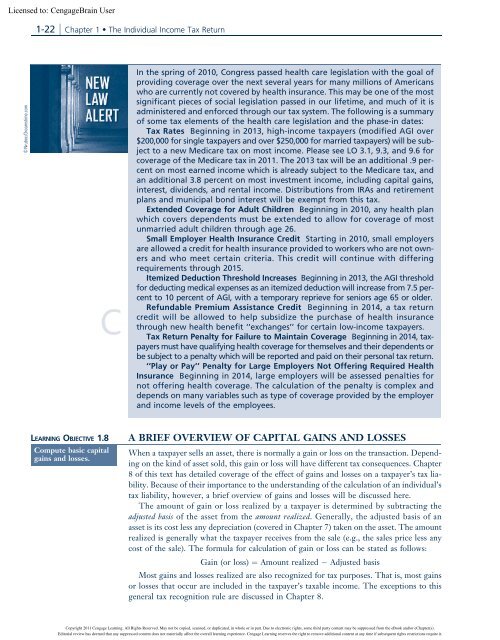Income Tax Fundamentals 2012, 30th ed. - CengageBrain
Income Tax Fundamentals 2012, 30th ed. - CengageBrain
Income Tax Fundamentals 2012, 30th ed. - CengageBrain
You also want an ePaper? Increase the reach of your titles
YUMPU automatically turns print PDFs into web optimized ePapers that Google loves.
Licens<strong>ed</strong> to:<br />
c Nruboc/Dreamstime.com<br />
1-22 Chapter 1 The Individual <strong>Income</strong> <strong>Tax</strong> Return<br />
In the spring of 2010, Congress pass<strong>ed</strong> health care legislation with the goal of<br />
providing coverage over the next several years for many millions of Americans<br />
who are currently not cover<strong>ed</strong> by health insurance. This may be one of the most<br />
significant pieces of social legislation pass<strong>ed</strong> in our lifetime, and much of it is<br />
administer<strong>ed</strong> and enforc<strong>ed</strong> through our tax system. The following is a summary<br />
of some tax elements of the health care legislation and the phase-in dates:<br />
<strong>Tax</strong> Rates Beginning in 2013, high-income taxpayers (modifi<strong>ed</strong> AGI over<br />
$200,000 for single taxpayers and over $250,000 for marri<strong>ed</strong> taxpayers) will be subject<br />
to a new M<strong>ed</strong>icare tax on most income. Please see LO 3.1, 9.3, and 9.6 for<br />
coverage of the M<strong>ed</strong>icare tax in 2011. The 2013 tax will be an additional .9 percent<br />
on most earn<strong>ed</strong> income which is already subject to the M<strong>ed</strong>icare tax, and<br />
an additional 3.8 percent on most investment income, including capital gains,<br />
interest, dividends, and rental income. Distributions from IRAs and retirement<br />
plans and municipal bond interest will be exempt from this tax.<br />
Extend<strong>ed</strong> Coverage for Adult Children Beginning in 2010, any health plan<br />
which covers dependents must be extend<strong>ed</strong> to allow for coverage of most<br />
unmarri<strong>ed</strong> adult children through age 26.<br />
Small Employer Health Insurance Cr<strong>ed</strong>it Starting in 2010, small employers<br />
are allow<strong>ed</strong> a cr<strong>ed</strong>it for health insurance provid<strong>ed</strong> to workers who are not owners<br />
and who meet certain criteria. This cr<strong>ed</strong>it will continue with differing<br />
requirements through 2015.<br />
Itemiz<strong>ed</strong> D<strong>ed</strong>uction Threshold Increases Beginning in 2013, the AGI threshold<br />
for d<strong>ed</strong>ucting m<strong>ed</strong>ical expenses as an itemiz<strong>ed</strong> d<strong>ed</strong>uction will increase from 7.5 percent<br />
to 10 percent of AGI, with a temporary reprieve for seniors age 65 or older.<br />
Refundable Premium Assistance Cr<strong>ed</strong>it Beginning in 2014, a tax return<br />
cr<strong>ed</strong>it will be allow<strong>ed</strong> to help subsidize the purchase of health insurance<br />
through new health benefit ‘‘exchanges’’ for certain low-income taxpayers.<br />
<strong>Tax</strong> Return Penalty for Failure to Maintain Coverage Beginning in 2014, taxpayers<br />
must have qualifying health coverage for themselves and their dependents or<br />
be subject to a penalty which will be report<strong>ed</strong> and paid on their personal tax return.<br />
‘‘Play or Pay’’ Penalty for Large Employers Not Offering Requir<strong>ed</strong> Health<br />
Insurance Beginning in 2014, large employers will be assess<strong>ed</strong> penalties for<br />
not offering health coverage. The calculation of the penalty is complex and<br />
depends on many variables such as type of coverage provid<strong>ed</strong> by the employer<br />
and income levels of the employees.<br />
LEARNING OBJECTIVE 1.8 A BRIEF OVERVIEW OF CAPITAL GAINS AND LOSSES<br />
Compute basic capital<br />
gains and losses.<br />
When a taxpayer sells an asset, there is normally a gain or loss on the transaction. Depending<br />
on the kind of asset sold, this gain or loss will have different tax consequences. Chapter<br />
8 of this text has detail<strong>ed</strong> coverage of the effect of gains and losses on a taxpayer’s tax liability.<br />
Because of their importance to the understanding of the calculation of an individual’s<br />
tax liability, however, a brief overview of gains and losses will be discuss<strong>ed</strong> here.<br />
The amount of gain or loss realiz<strong>ed</strong> by a taxpayer is determin<strong>ed</strong> by subtracting the<br />
adjust<strong>ed</strong> basis of the asset from the amount realiz<strong>ed</strong>. Generally,theadjust<strong>ed</strong>basisofan<br />
asset is its cost less any depreciation (cover<strong>ed</strong> in Chapter 7) taken on the asset. The amount<br />
realiz<strong>ed</strong> is generally what the taxpayer receives from the sale (e.g., the sales price less any<br />
cost of the sale). The formula for calculation of gain or loss can be stat<strong>ed</strong> as follows:<br />
Gain (or loss) ¼ Amount realiz<strong>ed</strong> Adjust<strong>ed</strong> basis<br />
Most gains and losses realiz<strong>ed</strong> are also recogniz<strong>ed</strong> for tax purposes. That is, most gains<br />
or losses that occur are includ<strong>ed</strong> in the taxpayer’s taxable income. The exceptions to this<br />
general tax recognition rule are discuss<strong>ed</strong> in Chapter 8.<br />
Copyright 2011 Cengage Learning. All Rights Reserv<strong>ed</strong>. May not be copi<strong>ed</strong>, scann<strong>ed</strong>, or duplicat<strong>ed</strong>, in whole or in part. Due to electronic rights, some third party content may be suppress<strong>ed</strong> from the eBook and/or eChapter(s).<br />
Editorial review has deem<strong>ed</strong> that any suppress<strong>ed</strong> content does not materially affect the overall learning experience. Cengage Learning reserves the right to remove additional content at any time if subsequent rights restrictions require it.










